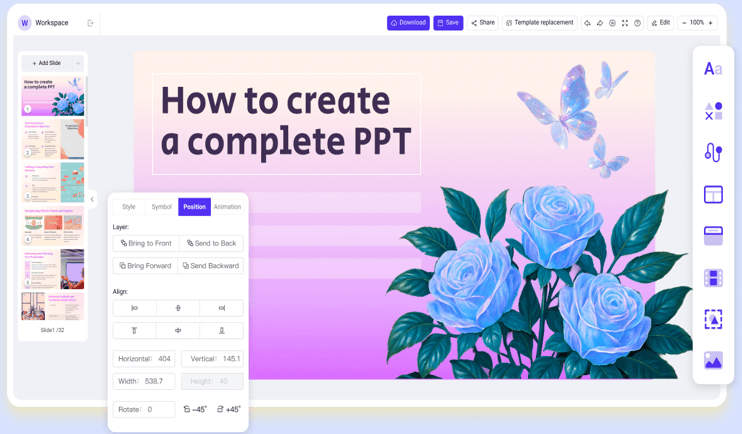
Have you ever stood on stage and felt your audience drift away? Someone showed no interest or even checked their phones. Often, it’s not because the topic is uninteresting, but rather because the way you present it is ineffective.
There is an effective presentation technique: Using storytelling in presentations. What is it? How to apply? This guide will show you the answer and more examples to help you captivate your audience, even if you are a novice presenter. Read it now!
What is Storytelling Presentation
Storytelling in presentations means sharing your message in the form of a story. Instead of just listing facts, you take your audience on a journey. This journey has a beginning, a middle, and an end.
For example, storytelling in business presentations can turn a sales report into an exciting story of a team overcoming a challenge.
Why Storytelling is Important in Presentations
Using stories is not just for fun. It is a smart way to communicate. Here are some Benefits of presentation storytelling:
- It keeps attention: People naturally pay more attention to stories than plain information.
- Build Trust: Telling a real story, especially a personal one, makes you seem more human and honest. This builds an emotional connection with the audience.
- It helps you persuade: If people understand the problem and feel the solution, they are more likely to agree with
- It makes your idea more memorable: A clear story stays in people’s minds long after the presentation ends.
Common Frameworks and Storytelling Presentation Examples
Here are a few common frameworks you can use:
1. The Hero's Journey
This is a classic structure. The “hero” is often your customer or your team.
The Hero: Introduce a main character (e.g., “This is Sarah, a small business owner.”)
The Challenge: The hero faces a big challenge (e.g., “Her business was failing during the lockdown.”)
The Guide: The hero finds a guide or a tool (your product or service) (e.g., “She found our online marketing course.”)
The Victory: The hero uses the tool to win (e.g., “Today, her online sales are 200% higher than before.”)
2. Problem-Solution
- Beginning (The Problem): You start by explaining a clear problem that the audience understands and cares about.
- Middle (The Solution): You introduce your idea or product as the solution to that problem.
- End (The Result): You show the successful outcome.
👉Example:
Beginning: “Our team was spending 10 hours every week on manual reports. Everyone was frustrated.”
Middle: “So, we built a simple new software to automate these reports.”
End: “Now, the team saves 10 hours, and everyone is focused on more important work.”
3. Case Study Story
This framework is perfect for storytelling in business presentations. It is not about theory; it is about real proof. It tells the story of a specific customer or situation to prove that your method works.
- The Client (The Situation): Introduce a real person or company. Give them a face and a name to make it real.
- The Struggle (The Conflict): Explain their specific pain point.
- The Solution (The Action): Explain exactly what you did for them.
- The Result (The Happy Ending): Show the data. This is the most important part of a case study.
👉Example:
“Meet Company X. They are a large retail business just like you.”
“Last year, their sales dropped by 15% because their website was too slow.”
“We used our new speed-optimization tool to fix their site in just two days.”
“One month later, their sales went up by 25%. This proves our tool works.”
4. Before-After
This framework clearly shows change or transformation.
- Before: You paint a picture of the world before your idea. This world has a problem.
- After: You show the new world after your solution was applied.
👉Example:
Before: “Look at this picture. Our city park was old, empty, and unsafe.”
After: “And here is the park today. It is clean, full of families, and a center for our community.”
How to Use Storytelling in Presentations
Applying these ideas is simple. Here is how to use storytelling in presentations:
Know Your Audience: Who are you talking to? What do they care about? What problems do they have? Your story must be about them, not just about you.
Find Your One Core Message: What is the one thing you want your audience to remember? Every story you tell must support this single message.
Find Your Hero: Who is the story about? It can be you, a customer, or even the audience. Make the hero relatable.
Add Conflict and Emotion: A story with no problem is boring. Show the challenge. What was difficult? How did it feel? This builds tension and keeps people listening.
Have a Clear End (The Call to Action): After the story, tell the audience what you want them to do now. The story should lead directly to this action.
✍ [You May Also Like]: How to Start a Presentation: 15 Tricks to Grab Attention
Making Your Slides Support Your Storytelling Presentation
Good storytelling needs good visuals. However, designing slides can take a long time. Now, WorkPPT AI Maker can help speed up the process.Reduce the production process from several hours to 60 seconds.
⭐⭐⭐⭐⭐ Rated 4.8 by 1.3M Users

How to use it:
1. Structure Automatically: Type your topic or upload a file to let the AI instantly generate an editable outline for your slide structure.
2. 5000+ Ready-to-use Templates: Choose a template that sets the right mood for your storytelling presentation.
3. Free Customization: The AI creates the slides in just a few seconds. You can also adjust text or images to highlight key story moments.
4. Share: Save and export your final visual story quickly as PPTX, PDF, or share it with a link.
Making Your Slides Support Your Storytelling Presentation
Q: Can I have just one vertical slide in a Google Slides presentation?
A: The shorter,the better. Around 30 to 60 seconds is suitable, no more than two minutes.The goal is maximum impact, not maximum length.
Q: Is storytelling suitable for all types of presentations?
A: Not always. Storytelling is great for presentations that need emotion, connection, or persuasion, such as sales pitches, team meetings, teaching, or project ideas. But some presentations work better with simple communication. This happens when your goal is only to share information, guide others, or report results.
Examples include
- performance reports
- financial reports
- data updates
- step-by-step instructions
- internal status updates
Q: What makes a good presentation story?
A: It needs high stakes (the conflict must matter). Most importantly, it must directly prove your core message.
Q: How do I use slides to support the story?
A: Slides should be minimal. Use high-impact images instead of dense text to convey feeling. To make this easy, tools like WorkPPT AI Presentation Maker help by quickly creating visually strong slides from your topic.
💬 Conclusion:
Storytelling in presentations makes your presentations clearer, more engaging, and easier to remember. You only need a short story, a clear problem, and one main message.
If you want to build slides faster, you can use WorkPPT . It turns your ideas into simple, well-structured slides in seconds. This saves time and helps you present with confidence.

